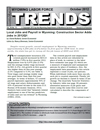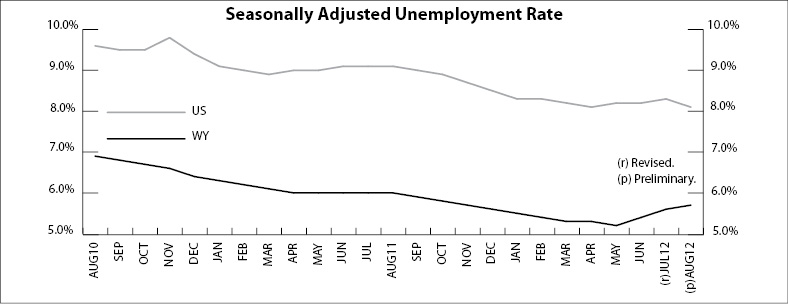
Wyoming Jobless Rate Rises to 5.7% in August 2012
The Research & Planning section of the Wyoming Department of Workforce Services has reported that the state’s seasonally adjusted1 unemployment rate increased from 5.6% in July to 5.7% in August (not a statistically significant change). August was the third consecutive month that unemployment has increased in Wyoming. The state’s jobless rate remained marginally lower than its year-ago level (6.0%) and significantly lower than the current U.S. unemployment rate (8.1%). Seasonally adjusted employment of Wyoming residents decreased by 720 individuals (-0.2%) from July to August.
From July to August, most county jobless rates followed their normal seasonal pattern and fell slightly. August tends to be among the peak months for employment, with seasonal job gains in construction, retail trade, and transportation, warehousing, & utilities. Large unemployment rate decreases were seen in Lincoln (down from 7.1% to 6.4%), Big Horn (down from 6.7% to 6.1%), and Sheridan (down from 6.2% to 5.7%) counties.
Fremont County posted the highest unemployment rate (6.6%) in August. It was followed by Lincoln (6.4%), Big Horn (6.1%), and Laramie (5.9%) counties. The lowest unemployment rates were found in Sublette (3.5%), Teton (4.1%), and Niobrara and Converse counties (both 4.2%).
From August 2011 to August 2012, jobless rates decreased in 21 counties and increased in two counties. The largest decreases occurred in Niobrara (down from 5.2% to 4.2%), Lincoln (down from 7.4% to 6.4%), Johnson (down from 6.2% to 5.3%), and Natrona (down from 5.7% to 4.9%) counties. Unemployment increased slightly in Sublette (up from 3.2% to 3.5%) and Park (up from 4.9% to 5.0%) counties.
The number of nonfarm jobs in Wyoming (measured by place of work) increased from an estimated 292,900 in August 2011 to 298,400 in August 2012, a gain of 5,500 jobs (1.9%).
1Seasonal adjustment is a statistical procedure to remove the impact of normal regularly recurring events (such as weather, major holidays, and the opening and closing of schools) from economic time series to better understand changes in economic conditions from month to month.

